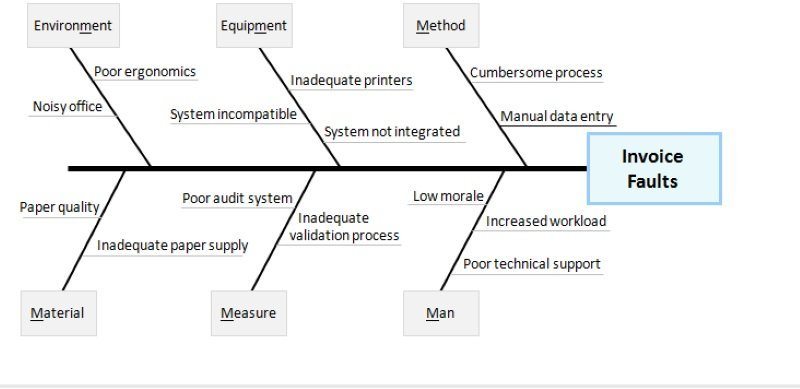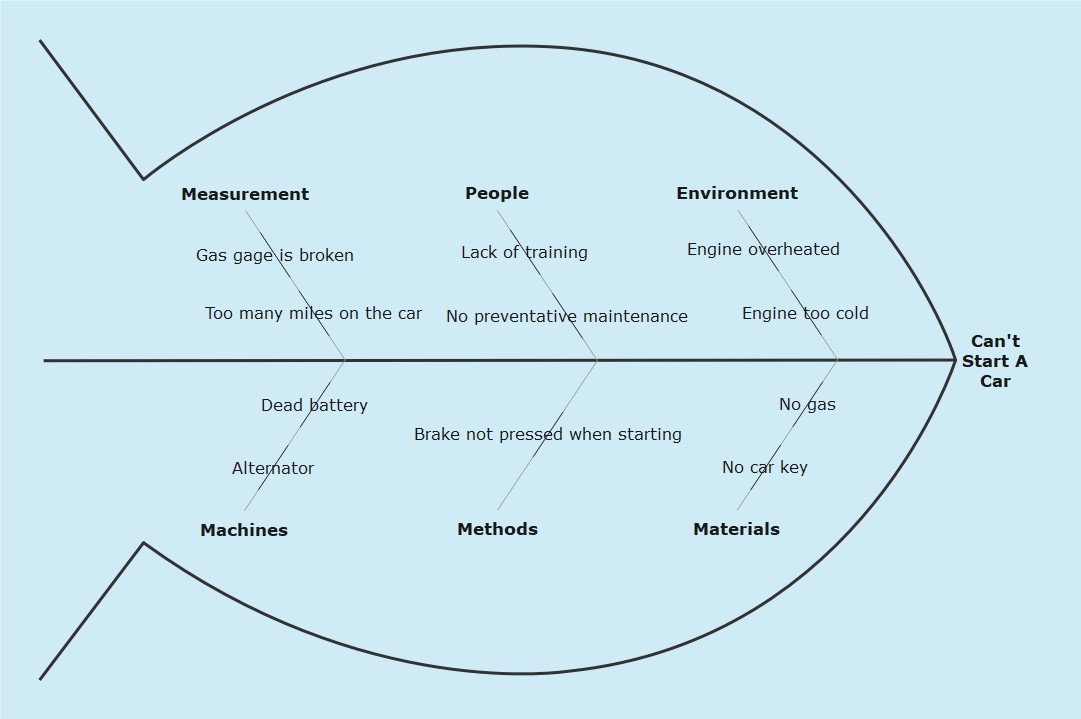
As long as the discussion keeps going, people are still brainstorming. #3: Keep brainstorming until the ideas run out. People are often unsure of how many causes to identify.

A common one is to start with the “People” category, but by the time 10 causes are identified under that category, you may choose to split it, for example as: “Nurses” and “Doctors.” Sometimes a main category can become too big. For example, “front desk is short-staffed” could be placed under the category of People, but also Culture. As a facilitator, remind the participants that listing the cause is more important than where it goes. #2: The cause is more important than the category. People often get confused or stuck on what category a cause should go into. Whereas “front desk is short-staffed” focuses on a potential cause (what to fix). For example, if the problem is delays at patient check-in, “add front desk personnel” offers a solution (how to fix). Simply acknowledge any comments by writing them to the side (don’t disregard any comments, it’s demoralizing) and help everyone remember the difference between the two. #1: Help the team focus on identifying causes, not solutions. It’s common for people to brainstorm solutions (how to fix), rather than causes (what to fix). Here are the top three tips for leading a successful fishbone: By reviewing each potential cause in detail, teams can identify areas where they need to make changes and eliminate errors.A successful fishbone diagram is led by a facilitator-one individual on the team who’s job is to remain impartial to the discussion, write down the identified causes on the fishbone diagram, and let the participant discussion flow freely. As the diagram develops, focus efforts on areas of the chart where causes are thinīy the time a chart is completed, teams have many options on the root causes leading to the final, problematic outcome.Teams again ask, “Why does this happen,” this time breaking down the possible causes in each category even further.Many of these lines come from asking the question: “Why does this happen?” Team members brainstorm all the possible causes within each category, writing them on branching lines from the main category lines.These typically fall into one of these areas: Methods, Machines, People, Materials, Measurement, Environment On lines branching off this centerline, list the categories where the causes are likely occurring.They write the statement on the center-right of the diagram, with a horizontal line running across to it Write a problem statement: This is the effect the team wants to change.Project teams should follow certain steps to ensure that they use a Fishbone Diagram properly. In Six Sigma, it’s used with an existing product or operation to identify and eliminate the causes of defects and errors. Today, the Fishbone Diagram is still frequently used in manufacturing and product development. Listening (the sound experience of the engine and wind while driving).Driving (ride stability, acceleration, etc.).Touch (the tactile experience of the car for drivers).Mazda famously took this approach in creating the Miata sports car (the MX5), detailing the six components that would make the final product. The diagram is useful in product development, where project teams list all the factors that contribute to making a product and break them down into smaller components.

The name Fishbone Diagram comes from the shape of the diagram, which when completed resembles the shape of a fish.

Based on an idea for problem-solving developed earlier in the 20 th century, Ishikawa’s diagram because popular in the 1960s at Kawasaki. Ishikawa invented the Fishbone Diagram for the shipbuilding industry in Japan. The use of a Fishbone Diagram requires that a team look at all possible causes for errors and mistakes, not just those they have come up with in the past or that team members suspect is the root cause.īecause of its usefulness, a Fishbone Diagram is one of the most popular tools in Six Sigma. It’s also useful for teams who find that their thinking on solving a challenge has fallen into a rut. Another name for the diagram is the Cause and Effect Diagram or Ishikawa Diagram (named for the diagram’s inventor, Kaoru Ishikawa).Ī Fishbone Diagram is an effective tool for project teams tasked with finding the root causes of a problem. A Fishbone Diagram is a visual tool that allows project teams to easily display a list of potential causes of a problem, then break these causes down into increasingly more detailed components until a link is found between a root cause and the final outcome.


 0 kommentar(er)
0 kommentar(er)
